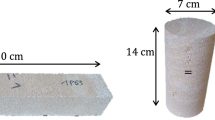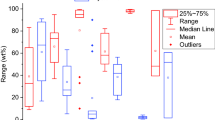Abstract
Apulia (southern Italy) is typified by widespread outcrops of rocks exploited in the last centuries in historical architectures and religious constructions, as building and decorative stone. Today, as in the past, these stones represent an important source for region economy and prestige, due to their uses for modern works, restoration of local medieval churches and also exporting abroad. Among these, a noteworthy and still poorly known material is the Carovigno stone. In this paper, firstly an overall view on the, mineralogical and petrophysical features of the stone was reached through a multianalytical approach based on several investigation procedures and techniques, including ultrasonic test, X-ray diffractometry, scanning electron microscopy, optical microscopy, mercury intrusion porosimetry. In order to simulate decay phenomena, the Carovigno stone samples were processed to three different ageing tests: cycles of thermal treatments at different high temperatures, cycles of heating–cooling and cycles of exposure to decahydrate sodium sulphate and sodium chloride saline solutions. During and after each ageing processes, mineralogical transformations and petrophysical changes were evaluated. Results suggested that the Carovigno stone is a fine-grained calcarenite, pure or nearly pure, characterized by high porosity and, consequently, very notable thermal stress resistance. Conversely, the type and amount of porosity causes stone predisposition to salt crystallization decay.








Similar content being viewed by others
References
Allison RJ, Bristow GE (1999) The effects of fire on rock weathering: some further considerations of laboratory experimental simulation. Earth Surf Proc Landf 24:707–713
Anania L, Badalà A, Barone G, Belfiore CM, Calabrò C, La Russa MF, Mazzoleni P, Pezzino A (2012) The stones in monumental masonry buildings of the ‘‘Val di Noto’’ area: new data on the relationships between petrographic characters and physical–mechanical properties. Constr Build Mater 33:122–132
Andriani GF, Germinario L (2014) Thermal decay of carbonate dimension stones: fabric, physical and mechanical changes. Environ Earth Sci 72(7):1–17
Andriani GF, Walsh N (2007) The effect of wetting and drying, and marine salt crystallization on calcarenite rocks used as building material in historic monuments. In: Prikryl R, Smith BJ (eds) Building stone decay: from diagnosis to conservation, vol 271. Geological Society London, Special Publications, London, pp 179–188
Andriani GF, Walsh N (2010) Petrophysical and mechanical properties of soft and porous building rocks used in Apulian monuments (south Italy). Geol Soc Lond Spec Publ 333:129–141
ASTM D 4404-84 (1999) Standard test method for determination of pore volume and pore volume distribution of soil and rock by mercury intrusion porosimetry, designation D 4404-84 (Reapproved 1992). Annual Book of ASTM Standards 04.08:588–592
Barbera G, Barone G, Mazzoleni P, Scandurra A (2012) Laboratory measurement of ultrasound velocity during accelerated aging tests: implication for the determination of limestone durability. Constr Build Mater 36:977–983
Brewer R (1964) Fabric and mineral analysis of soils. Wiley, New York
Calia A, Laurenzi Tabasso M, Mecchi AM, Quarta G (2014) The study of stone for conservation purposes: Lecce stone (southern Italy). Geol Soc Lond Spec Publ 391:139–156
Cantisani E, Pecchioni E, Fratini F, Garzonio CA, Malesani P, Molli G (2009) Thermal stress in the Apuan marbles: relationship between microstructure and petrophysical characteristics. Int J Rock Mech Min 46:128–137
Cardell C, Delalieux F, Roumpopoulos K, Moropoulou A, Auger R, Van Grieken R (2003) Salt-induced decay in calcareous stone monuments and buildings in a marine environment in SW France. Constr Build Mater 17:165–179
Cherubini C, Reina A, Bruno D (2007) Le rocce tenere del Salento: proposta di classificazione con l’uso delle caratteristiche tecniche e meccaniche. Geologi e Territorio 2:34–47
Dunham RJ (1962) Classification of carbonate rocks according to depositional texture. Am Assoc Pet Geol 1:108–121
El-Gohary M (2011) Chemical deterioration of Egyptian limestone affected by saline water. Int J Conserv Sci 2(1):17–28
EN 12370 (2001) Metodi di prova per pietre naturali. Determinazione della resistenza alla cristallizzazione dei sali. CNR-ICR, Rome
EN 14579 (2004) Natural stone test methods—determination of sound speed propagation. CEN, Brussels
EN 1925 (2000) Metodi di prova per pietre naturali. Determinazione del coefficiente di assorbimento d’acqua per capillarità. CNR-ICR, Rome
Franzoni E, Sassoni E, Scherer GW, Naiduc S (2013) Artificial weathering of stone by heating. J Cult Herit 14(3):e85–e93
Lazzarini L, Laurenzi Tabasso M (1986) Il restauro della pietra. CEDAM, Padova
Luperto Sinni E (1996) Sintesi delle conoscenze biostratigrafiche del cretaceo del Gargano e delle Murge. Memorie Società Geologica Italiana 51:995–1018
Luperto Sinni E, Borgomano J (1989) Le Crétacé Supérieur des Murges sud-orientales (Italie méridionale): stratigraphie et évolution des paléoenvironnements. Riv Ital Paleontol S 95(2):95–136
Molina E, Cultrone G, Sebastian E, Alonso FL, Carrizo L, Gisbert J, Buj O (2011) The pore system of sedimentary rocks as a key factor in the durability of building materials. Eng Geol 118:110–121
Mutluturk M, Altindag R, Turk G (2004) A decay function model for the integrity loss of rock when subjected to recurrent cycles of freezing–thawing and heating–cooling. Int J Rock Mech Min 41:237–244
Ricchetti G, Ciaranfi N, Luperto Sinni E, Mongelli F, Pieri P (1988) Geodinamica ed evoluzione sedimentaria e tettonica dell’avampaese apulo. Memorie Società Geologica Italiana 41:57–82
Rothert E, Eggers T, Cassar J, Ruedrich J, Fitzner B, Siegesmund S (2007) Stone properties and weathering induced by salt crystallization of Maltese Globigerina Limestone. In: Prikryl R, Smith BJ (eds) Building stone decay: from diagnosis to conservation, vol 271. Geological Society London, Special Publications, London, pp 189–198
Ruiz-Agudo E, Mees F, Jacobs P, Rodriguez-Navarro C (2007) The role of saline solution properties on porous limestone salt weathering by magnesium and sodium sulfates. Environ Geol 52:269–281
Siegesmund S, Ullemeyer K, Weiss T, Tschegg EK (2000) Physical weathering of marbles caused by anisotropic thermal expansion. Int J Earth Sci 89:170–182
Sippel J, Siegesmund S, Weiss T, Nitsch KH, Korzen M (2007) Decay of natural stones caused by fire damage. In: Prikryl R, Smith BJ (eds) Building stone decay: from diagnosis to conservation, vol 271. Geological Society London, Special Publications, London, pp 139–151
Spalluto L, Caffau M (2010) Stratigraphy of the mid-Cretaceous shallow-water limestones of the Apulia Carbonate Platform (Murge, Apulia, southern Italy). Ital J Geosci (Boll Soc Geol Ital) 129(3):335–352
Tucci P, Morbidelli P (2004) Apulian marbles: recognition and characterisation of ancient quarries finalised to archaeometric aims. Ostuni District (South-Eastern Murge, Apulia, Italy). Period Miner 73:127–140
Tucci P, Morbidelli P, Imperatori C (2007) Study for restoration purposes about the obelisk located in ‘Piazza della Libertà’ at Ostuni (Brindisi, Southern Italy). Period Miner 76(1):59–73
Vázquez P, Acuña M, Benavente D, Gibeaux S, Navarro I, Gomez-Heras M (2016) Evolution of surface properties of ornamental granitoids exposed to high temperatures. Constr Build Mater 104:263–275
Yavuz H, Altindag R, Sarac S, Ugur I, Sengun N (2006) Estimating the index properties of deteriorated carbonate rocks due to freeze–thaw and thermal shock weathering. Int J Rock Mech Min 43:767–775
Yavuz H, Demirdag S, Caran S (2010) Thermal effect on the physical properties of carbonate rocks. Int J Rock Mech Min 47:94–103
Acknowledgements
This research was supported by MIUR (Italian Ministry of Education, University and Research) ex MURST 60%. Many thanks to Mr. Marcello Andriani of the Leo Martino company, for providing samples of the Carovigno stone, essential for this experimental research.
Author information
Authors and Affiliations
Corresponding author
Rights and permissions
About this article
Cite this article
Fioretti, G., Mazzoleni, P., Acquafredda, P. et al. On the technical properties of the Carovigno stone from Apulia (Italy): physical characterization and decay effects by means of experimental ageing tests. Environ Earth Sci 77, 17 (2018). https://doi.org/10.1007/s12665-017-7201-9
Received:
Accepted:
Published:
DOI: https://doi.org/10.1007/s12665-017-7201-9




